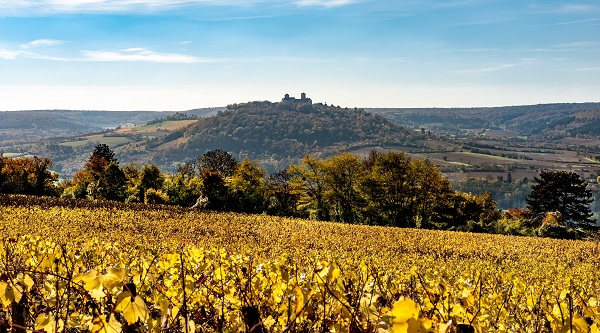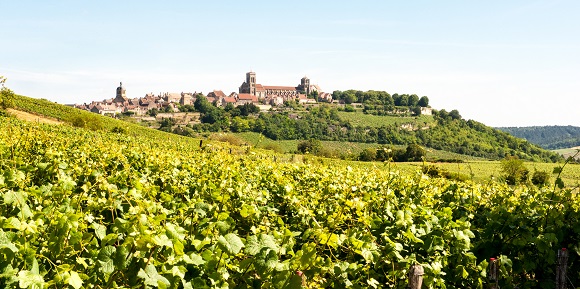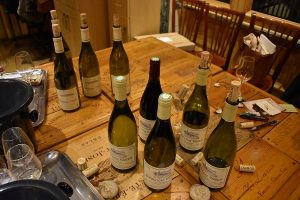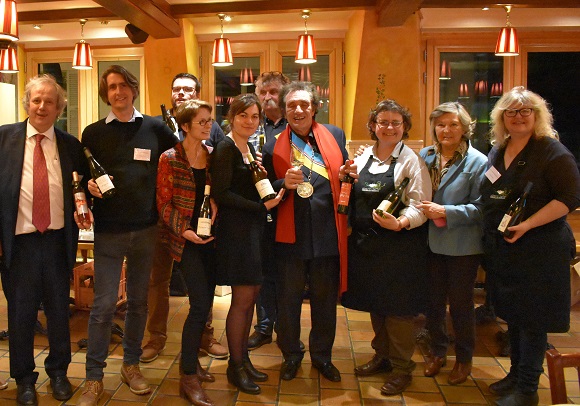
Vézelay vineyards with the hilltop village of Vézelay in the background © Nathalia Guimaraes.
From time to time a winegrowing area will flex its viney muscle and, claiming distinctiveness, seek to untether itself from broader semi-generic wines in a region.
Vézelay, a Burgundy village otherwise known as a UNESCO World Heritage Site, is the latest to make a name for itself. In the fall of 2017 Vezelay was officially granted permission to call its dry chardonnays “Vézelay” rather than the broader “Bourgogne [Burgundy] Vézelay.” It’s a subtle but proud distinction that allows its producers to affirm and refine their wines’ particularity compared with other white burgundies.
In France, permission to bear a village label comes from the INAO, the National Institute of Appellations of Origin, which is responsible for the implementation of policy on official signs of identification of the origin and quality of agricultural and food products.
From now on, Vézelay, like Twiggy, Cher, Madonna, Beyoncé, Moby, Ice-T, Oprah and Voltaire, needs no other qualifier to its name to make a statement.
The last Burgundy village to rise to appellation (AOC) status was Irancy, in 1999, for its rough-edged pinot noir produced 22 miles north of Vézelay. Now it’s the turn for chardonnay, the other illustrious grape of Burgundy wines, to get honored as Vezelay comes of age and out from the long shadow of white Burgundy.

The first AOC Vezelay bottles will appear on wine shop shelves in the fall of 2018. That’s just in time for the best launch party that a Burgundy village can have, as Vézelay will host the region’s annual Saint Vincent Tournante wine festival over the weekend of January 26 and 27, 2019.
 Each year the Confrérie des Chevaliers du Tastevin, the venerable and folkloric wine fraternity of Burgundy wine enthusiasts (and of much else Burgundy), selects a different Burgundy wine village to host the event. That village then shares the fermented fruit of its labor in honor of Vincent, a patron saint of winegrowers. Vézelay was awarded the 2019 slot when Aloxe-Corton and Pernand-Vergelesses, which historically host the event together, backed out due to a series of small harvests that left them low on party stock. January may not be the most beautiful time for a stroll in the vineyards, but Saint Vincent Tournante is one of France’s premier wine parades. (The January 2020 event will likely be held in Gevrey-Chambertin, the Côte de Nuits village whose grand cru reputation needs no introduction to fans of French wines and to visitors to Burgundy.)
Each year the Confrérie des Chevaliers du Tastevin, the venerable and folkloric wine fraternity of Burgundy wine enthusiasts (and of much else Burgundy), selects a different Burgundy wine village to host the event. That village then shares the fermented fruit of its labor in honor of Vincent, a patron saint of winegrowers. Vézelay was awarded the 2019 slot when Aloxe-Corton and Pernand-Vergelesses, which historically host the event together, backed out due to a series of small harvests that left them low on party stock. January may not be the most beautiful time for a stroll in the vineyards, but Saint Vincent Tournante is one of France’s premier wine parades. (The January 2020 event will likely be held in Gevrey-Chambertin, the Côte de Nuits village whose grand cru reputation needs no introduction to fans of French wines and to visitors to Burgundy.)
Vezelay Abbey
Its hosting of Saint Vincent Tournante makes 2019 a double reason for Vézelay pride since that also marks the 40th anniversary of the listing of its 12th-century basilica and its dramatic hilltop presence as a UNESCO World Heritage Site. The Benedictine abbey of Vézelay was founded in the 9th century and eventually acquired the supposed relics of Saint Mary Magdalene, leading to the church being rededicated in her name in the 11th century. Miracles were attributed to the relics, pilgrims flocked in increasing numbers, and the church became an important point of departure along Saint James’s Way. The church, rebuilt following a deadly fire in 1120, is “a masterpiece of Burgundian Romanesque art and architecture,” to quote the UNESCO listing. The perfect setting, then, for Saint Bernard to preach the Second Crusade in 1146 and for Richard the Lion-Hearted and Philip II Augustus to set off in bromance for the Third Crusade in 1190.
With all that communion going on, as well as the thirst of the Court of Burgundy, there was much need for wine, and vineyards flourished around medieval Vézelay.
(The Vezelay Tourist Office provides information about visiting the abbey, the village and the surrounding villages and vineyards, including Vezelay wine tasting.)
The appellation and the terroir
But Vézelay’s long winemaking history, dating to Roman times, dried up with the phylloxera epidemic that hit the area in 1884 and soon decimated the vines. Several acres of vines were later replanted for local consumption, but it wasn’t until the 1970s, when a handful of producers, with support from some elected officials, made a concerted effort to relaunch local wine production with the pinot noir and especially chardonnay varietals that are so at home in Burgundy. Their efforts gradually bore fruit, and in 1988 the area’s chardonnay production was authorized to bear the Bougogne/Burgundy appellation. In 1997 that gave way to the appellation Bourgogne Vezelay. Consecration has now come with the AOC Vezelay designation, which recognizes the distinctiveness of these chardonnays compared with others in the region.
Twenty-five producers, including ten associated with a cooperative, currently work 70 hectares (173 acres) of chardonnay vines. That leaves plenty of room for growth since the new appellation delimits a zone covering 256 hectares (633 acres).
AOC Vézelay defines a dry white wine produced from the chardonnay B varietal. In granting it an appellation in its own right, INAO recognizes it as a well-defined and independent geographical entity within Burgundy. The outline of the Vézelay winegrowing zone lies in the Cure Valley within the municipalities of Asquins, Saint-Père, Tharoiseau and Vézelay in Burgundy’s Yonne department or subregion. Its clayey marly limestone soils are situated on southern and southeastern slopes on the edge Morvan National Regional Park and distinct from Burgundy’s Chabliens/Auxerrois vineyards, also in Yonne, to the north and its Côte d’Or vineyards to the southeast.

Having a village appellation does not mean that a wine is exceptional but rather that it is distinct from neighboring wines and follows certain specifications. Consequently, it presents a specificity in the marketplace that is up to its producers and distributors to exploit. In and of itself, it is not a gauge of quality with respect non-village wines, though a village appellation is presumably not plonk. Of course there is still room for varying tastes and qualities within the production area.
Vézelay, or at least the Bourgogne Vézelay currently on the market, might best be considered a fresh, unpretentious dry aperitif with floral, citrus and mineral notes. You can always keep pouring it beyond the aperitif to accompany a starter, if you like, or to finish with some soft cow’s milk cheese. See AOC Vézelay’s description by the Bourgogne Wine Board (BIVB).
Bourgogne Vézelay can already be found in some U.S. and British wine markets, so AOC Vézelay will certainly follow suit and perhaps grow as the vineyards and their “brand” reputation do. In France, bottles of Bourgogne Vézelay sell in shops in the 10-15€ range for the most part. The new village appellation and accompanying marketing efforts may well lift prices. (Keep in mind, we are not in Chablis Grand Cru territory here.)
For a lesson in English of the geography of Burgundy appellations (pre-AOC Vezelay), south to north, see this video from the Bourgogne Wine Board.
Vezelay in Montmartre
A group of Vézelay winegrowers recently came to Paris to speak of the new appellation at an event at the La Bonne Franquette, a restaurant located just up the street the vineyard of Montmartre. La Bonne Franquette is also an institution of Montmartre folklore, hence the presence of President of the Republic of Montmartre in the photo below. He is seen holding a bottle of Montmartre wine, as is Patrick Frashboud, La Bonne Franquette’s owner. The other bottles held are among the last of the Bourgogne Vézelay chardonnay production.

Left to right, Patrick Fracheboud, owner of La Bonne Franquette; Matthieu Woillez, Domaine La Croix Montjoie; Valentin Montanet, Domaine La Cadette; Elise Villiers, Domaine Elise Villiers; Delphine Dupont, Domaine Dupont; Patrick Bringer, Domaine Les Faverelle; Alain Coquard, President of the Republic of Montmartre; Brigitte Guéret, Cave Henry de Vézelay, the Vezelay wine cooperative; Christine Ranunkel, whose father was an elected official instrumental in pushing for the replanting the vineyards around Vezelay in the 1960s and 70s; Isabelle Garnier, Cave Henry de Vézelay.
© 2018, Gary Lee Kraut

